Crab Nebula Lightshow |
RIP Pat Chapman 20/12/1940 - 23/07/2022 |
| Personnel - Pat Chapman (Dec'd) |
A history of the Crab Nebula Lightshow - Part 1:I fell in love with stage lighting aged 15 at school. I sent of for all the catalogues (I still have them) and I learnt electrical wiring and circuitry. I lit the school plays, and lit the school dances (it was a co-ed school), but I was better at pointing 1Ks at females than dancing with them! I worked at the Lyric for the next school hol, but in the summer, they had no work for me, but Pat Fearon, the then resident stage manager gave me a recommendation to a mate of his in the hallowed West End. The year was 1958. The job was as a stagehand at the Coliseum Theatre Most Happy Fella. But it was lighting (electrics) that I wanted to work on. The next summer I worked for the BBC at the TV Centre, and remember well the live dramas like Dixon of Dock Green, the Variety shows at the BBC's Shepherd's Bush Empire.
I was particularly interested in Strand Electric's new light consoles, some of which were organ consoles complete with organ-type, stops and foot pedals. They were revolutionary, and were replacing all the old Grand Master dimmer boards in most London theatres. But few of the old school electricians would or could make the change from old to new techniques, and believe me, the learning curve was huge. It's not unlike today's computer learning curve which older people find so hard to come to terms with. The result was that there was a desperate shortage of console operators, and I just loved consoles. True I had only worked them in my mind at first, but I had got organ and piano Grade exams, and I went to Strand Electric's King Street HQ and met Freddie Bentham, the designer of the consoles, and the famous Pattern 23 lantern, also the great exponent of 'colour music'. There in the King Street basement, he had his own 'demonstration' organ console, a cyclorama, and full lighting rig. He showed his, the console's, and the equipment's verstatility by 'playing' his organ to accompany recorded music. He called it Light Music. Bentham had designed all this before the war, but it all went on hold for decades. But it was enough and I was confident enough to tell the various chief electricians, that I was a console operator. On the principle that I knew more than them, it worked. My first job was as deputy console operator on Sound of Music at the Palace Theatre. Luckily, I was gently eased into operating, and remember well my fist show solo a Wednesday matinée. So it was nigh on impossible to get. However, with the console operator shortage, I got mine as I walked into the theatre on my first day. I worked 165 Sound of Musics over 6 months. Over the next four years I worked at also worked at many other London West End theatres specialising in musicals (Palace Theatre Flower Drum Song/ New Theatre Oliver, Drury Lane Theatre My Fair Lady/ Palladium - various shows, inc ATV's 'Sunday Night at the London Palladium)/ Princes Theatre How to Succeed in Business without really trying', etc, etc.. During this period, I left school, and believing a paper qualification was essential to life, I went to Central (Drama School in NW3 to train as a stage and TV lighting designer. However, though I stuck at it for the two year course, the course was very lacking, and, knowing I was learning more in the West End, I stuck with my part-time theatre work, some listed above (mostly evenings and as many matinees as I could wangle, plus any amount of time during hols). I do remember one short job I did was as a hemp fly-man at the Edgware Road Met (now sadly demolished). In those days they had strippers. Being on the fly gallery, we had a wonderful overhead view into the girl's quick change room in the wings! After I finished at Central, I then worked at the Belgrade Theatre Coventry for 18 months, and topped it off by working at Coventry Cathedral for the 2 week programme of theatre, concerts, opera and ballet for its consecration. I then left the business and went into the RAF (1963-1966) to serve a three year commission during which I trained as pilot on fast jets. When I came out I went into a different industry, but had a yearning for my beloved stage lighting. It was the emergence of rock and roll, the disco and ever-increasingly large pop groups. The first rock festivals/concerts were also happening. By chance, in 1967, I made friends with a lively group of young people from Weybridge, who were 10 years my junior. One was quite wealthy, as were his friends and peers, and he had wormed his way into doing discos at their costly house parties. I went to some of these and suggested we might add lighting. By coincidence I also got a mature student's place at Fitzwilliam College, and we immediately got contracts to do our disco and light shows, as they were beginning to be called. We also got the contracts to do all the sound and lights at a number of Cambridge May Balls. In the summer of 1968 a number of things happened. We saw Pink Floyd at the cellars in Covent Garden, and I was mightily impressed by their lighting. Also there were resident liquid slide shoes each week, and I learned by watching how it was done and what gear they used. We also saw the Grateful Dead at the Roundhouse and noted their light show techniques. All I had to do was to purchase some projectors (Aldis Tutors) and purchase the 'liquids' and other items, and practice. During the year, Cambridge scientists had 'discovered an exploding star, and dated its explosion to 1054 AD. They called it the Crab Nebula. I was still a Cambridge undergraduate,and like with my drama school time, I was juggling attendance -luckily minimal required, with my weekend lighting career! Pictures of the new find, and the first to be so identified, were beautiful, mysterious and awesome. With my Cambridge connection it seemed apt in all respects to call my light show Crab Nebula. Technically Crab Nebula grew to become very sophisticated. The biggest shows could go out with 30 Aldis 2 projectors, 4 Kodak Carousel projectors, 3000+ 35mm slides, a graphic artist/photographer producing slides in its own darkroom. Pooterland.com would like to thank Pat Chapman for the text that appears on this page. © Pat Chapman 2001 All rights reserved. |
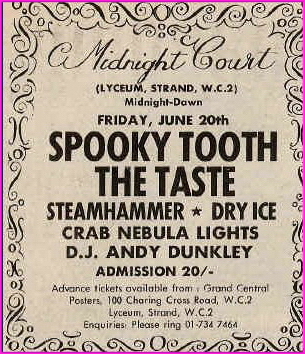 |
June 1969 |
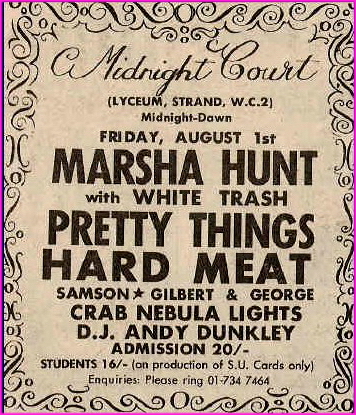 |
August 1969 |
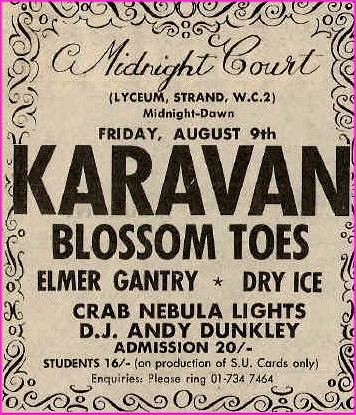 |
August 1969 |
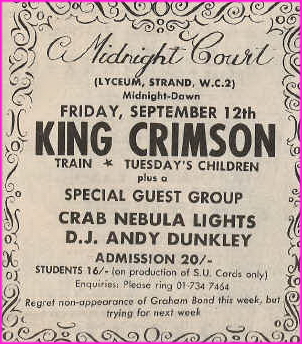 |
September 1969 |
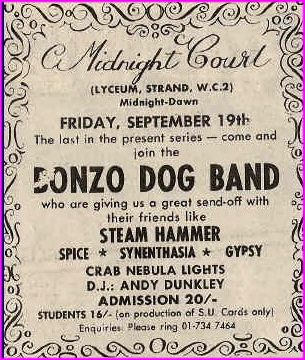 |
September 1969 |
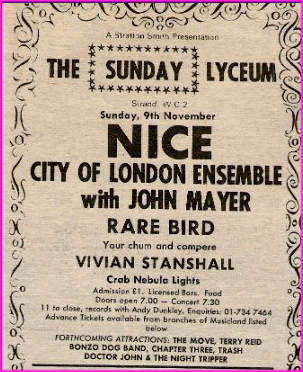 |
November 1969 |
